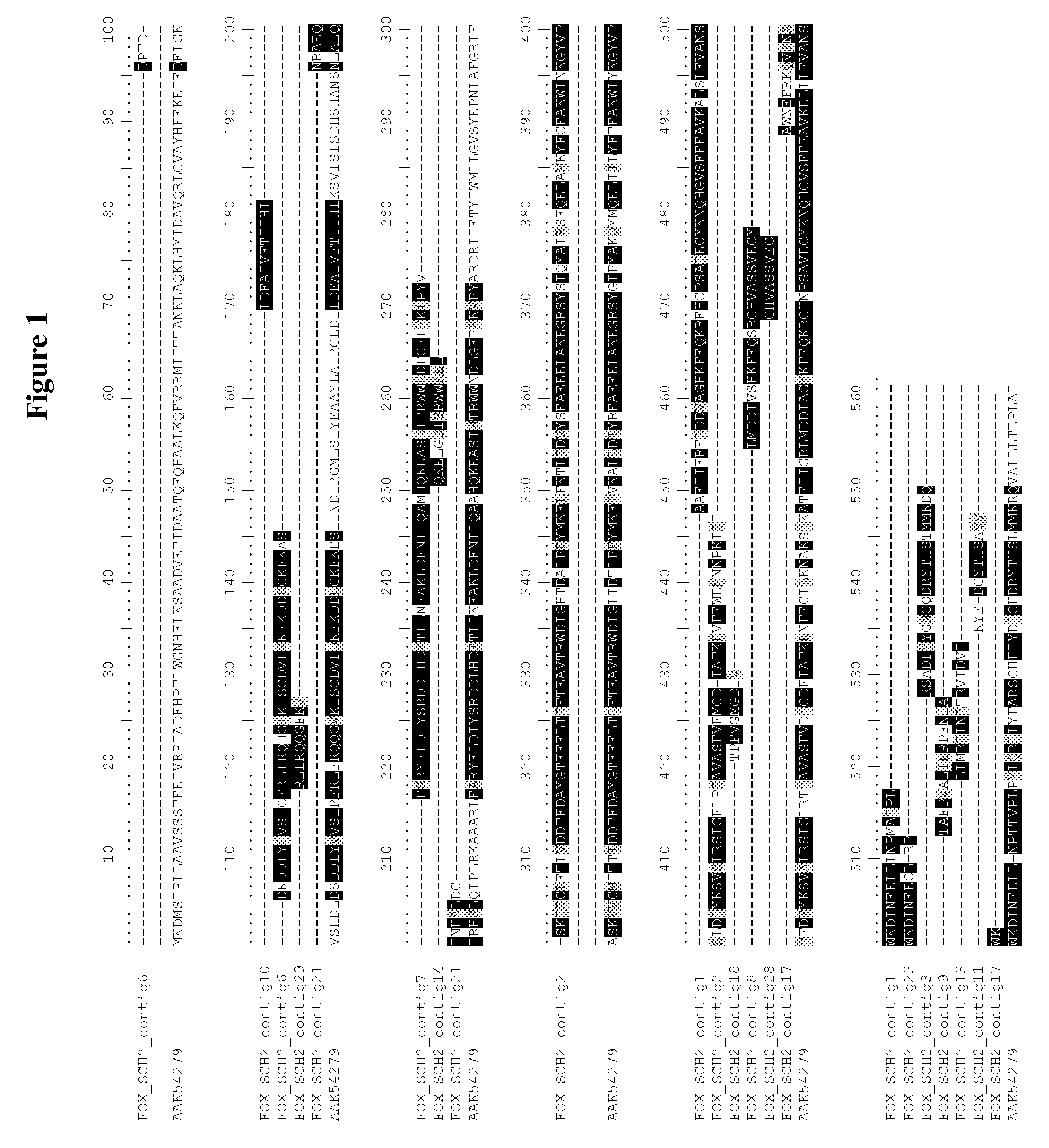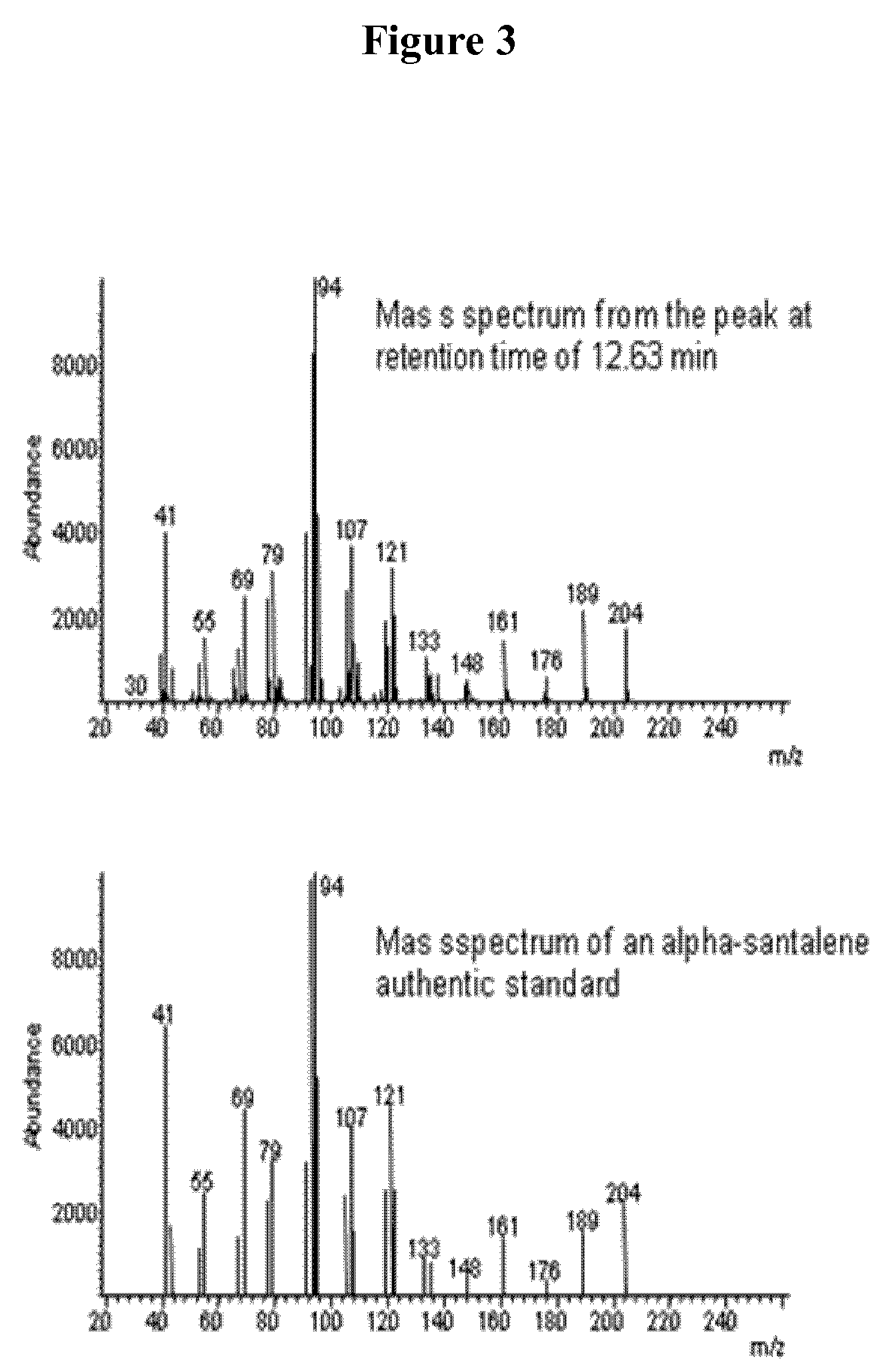Method for producing α-santalene
a technology of santalene and santalene, which is applied in the direction of lyases, carbon-oxygen lyases, enzymology, etc., can solve the problems of difficult or even impossible to use such ingredients in high-quality perfumery, the availability of sandalwood raw materials has dramatically decreased in the past decade, and the isolation and characterization of terpene synthases are still difficul
- Summary
- Abstract
- Description
- Claims
- Application Information
AI Technical Summary
Benefits of technology
Problems solved by technology
Method used
Image
Examples
example 1
Plant Material and cDNA Library Construction
[0137]Seeds of Clausena lansium (wampee) were obtained from farmers located in the Hainan province in China and particularly in the town of FuShan (ChengMai County) and the town of Yongxing (Haikou City). The seeds were germinated and the plants cultivated in a greenhouse.
[0138]Young leaves (1 to 2 cm long) were collected and used for the construction of a cDNA library. Total RNA was extracted from the leaves using the Concert™ Plant RNA Reagent from Invitrogen (Carlsbad, Calif.) and the mRNA were purified by oligodT-cellulose affinity chromatography using the FastTrack® 2.0 mRNA isolation Kit (Invitrogen, Carlsbad, Calif.) according to the manufacturer's instructions. A cDNA library was constructed from this mRNA and using the Marathon™ cDNA Amplification Kit (Clontech, Mountain View, Calif.).
example 2
Massively Parallel Sequencing of the C. lansium Leaf cDNA Library
[0139]We used the technology of massive parallel sequencing of small DNA fragments developed by Illumina (San Diego, Calif.) to obtain sequence information of the whole cDNA library made from wampee small leaves. This sequencing technique uses a reversible terminator-based sequencing chemistry and the Cluster Station and Genome Sequencer apparatuses developed by Solexa and Illumina (www.illumina.com).
[0140]The cDNA library (1 μg) was first loaded on an agarose gel and the bands corresponding to a size between 1.5 and 3 Kb were excised, eluted and used for the sequencing. This size enrichment avoids the dilution of the library by some cDNAs encoding for proteins involved in primary metabolism (such as for example the ribulose-1,5-bisphosphate carboxylase) which often are present in high proportion in library made from plant tissues and specially green tissues. The target cDNAs, encoding for sesquiterpene synthases, typi...
example 3
Amplification of Full-Length Sesquiterpene Synthases cDNAs
[0144]The sesquiterpene synthases-specific primers deduced from the massively parallel sequencing (Example 2) were used in combination with cDNA adaptor primers in 3′ / 5′RACE type PCR amplifications. The amplifications were performed using the C. lansium cDNA library, prepared as described above in Example 1, and the Advantage® 2 Polymerase Mix (Clontech) following the Marathon™ cDNA Amplification Kit protocol (Clontech, Mountain View, Calif.). The thermal Cycling conditions were as follows: 1 min at 94° C., 32 cycles of 1 min at 94° C. and 3 min at 68° C., and 3 min at 68° C.
[0145]Using the FS2_cont2_F1 primer (SEQ ID NO:20), a 1049 by DNA sequence was obtained. Analysis of the sequences of several clones obtained from this amplification showed that two sequence variants were present (Cont2_RACE_F1 (SEQ ID NO:23) and Cont2_RACE_F2 (SEQ ID NO:25)) with 96% sequence identity. Each of the two sequences corresponded to the 3′ end...
PUM
| Property | Measurement | Unit |
|---|---|---|
| optimal temperature | aaaaa | aaaaa |
| optimal temperature | aaaaa | aaaaa |
| optimal temperature | aaaaa | aaaaa |
Abstract
Description
Claims
Application Information
 Login to View More
Login to View More - R&D
- Intellectual Property
- Life Sciences
- Materials
- Tech Scout
- Unparalleled Data Quality
- Higher Quality Content
- 60% Fewer Hallucinations
Browse by: Latest US Patents, China's latest patents, Technical Efficacy Thesaurus, Application Domain, Technology Topic, Popular Technical Reports.
© 2025 PatSnap. All rights reserved.Legal|Privacy policy|Modern Slavery Act Transparency Statement|Sitemap|About US| Contact US: help@patsnap.com



